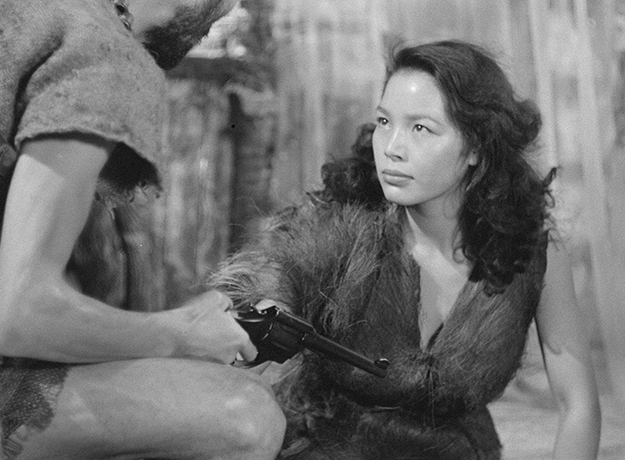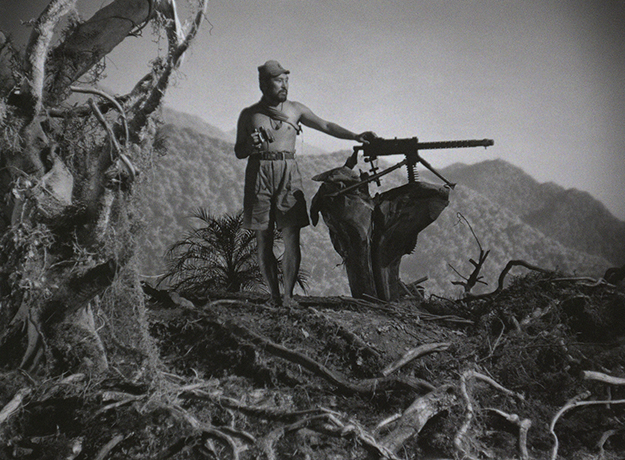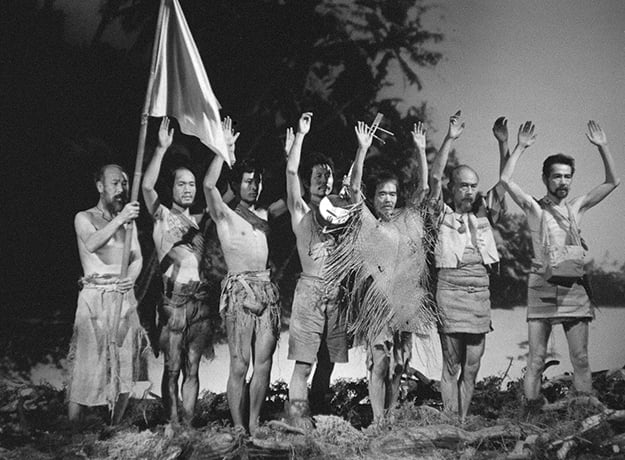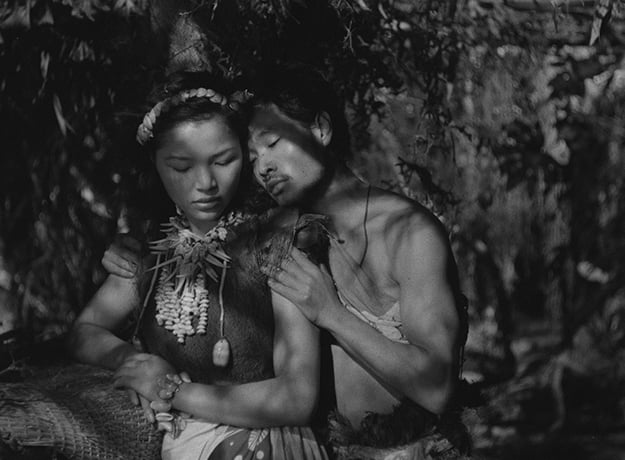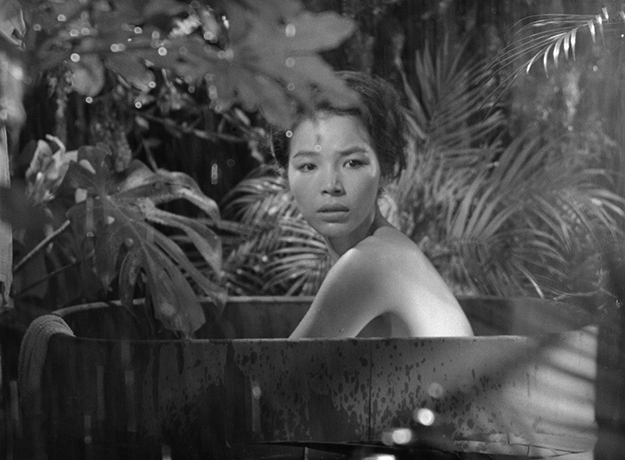A few weeks before Kino Lorber’s April 25 Blu-ray release of Josef von Sternberg’s Anatahan (aka The Saga of Anatahan), an online writer mused that he didn’t know anybody who had seen the movie. As a matter of fact, it only received what seems to have been a token theatrical release in 1954, and later, in 1977, Twyman Films, a Dayton, Ohio, rental outfit, distributed the film in 16mm. Unfortunately, the bookings did not flood in. My understanding is that in return for a partial investment and his professional services as writer, director, and cinematographer, Sternberg was given the Western Hemisphere rights. If so, it must have been a bitter financial disappointment. It was a long ride down from Sternberg’s lofty position as one of the triumvirate that made up the directorial heart of Paramount, with Cecil B. DeMille and Ernst Lubitsch forming the other two points. After Sternberg and Marlene Dietrich broke up their legendary partnership in 1935, he moved nomadically through a series of studios to steadily diminishing returns: Columbia for Crime and Punishment (1935); Korda for the aborted I, Claudius (1937); MGM for Sergeant Madden (1939); United Artists for The Shanghai Gesture (1941), culminating as a glorified assistant to King Vidor on Duel in the Sun (1946) before his two (heavily reshot) films for Howard Hughes and RKO: Macao (1952) and Jet Pilot (1957).
Yet, with each failure, his arrogance only increased. Cinematographer Paul Ivano told me of Sternberg setting up a blackboard on the set of The Shanghai Gesture. Any member of the crew with a question had to sign in before Sternberg would deign to speak to them. The late writer Steven Bach was a student of Sternberg’s when he taught at UCLA, and got to know him outside of class. He said that Sternberg was one of the most profoundly unhappy men he had ever known. None of these pictures have much of a reputation today, but I’d like to say a word on behalf of The Shanghai Gesture. The version available at present is missing about 15 minutes, but a few years ago I saw a print of the complete version and it was a revelation—the editing of the shortened version was done by lopping out entire scenes and sometimes the culmination of beautiful shots. The result was that the expressive downward arc of the characters was garbled. The film isn’t The Last Command or Shanghai Express, but it’s far from negligible. Creatively, Anatahan is not a disappointment so much as it is a curiosity. It’s certainly in line with Sternberg’s primary narrative theme—a stunning, emotionally distant woman who leads men first to distraction, then destruction. A large part of Sternberg’s work is a competition for sexual subjugation, but he needed actors with an erotic charge to compensate for his naturally cold, ironic temperament. Because the men in Anatahan are wartime Japanese sailors who have washed up on an island after their freighter has been sunk by American planes, the scene is set for a sexually charged, Japanese version of Ten Little Indians.
And some of that process of elimination actually takes place. One man after another becomes the consort of Keiko, dubbed “the Queen Bee” in Sternberg’s narration, but only after they kill off the previous one. Keiko (Akemi Negishi) is mostly a passive observer, although Sternberg suggests that she thrives on the attention, which she actively encourages through discreet displays of nudity. The years had not dulled Sternberg’s eye for female sensuality. With her decisive, pantherish movements that contrast with languid come-hither moments, Negishi is a worthy successor to Dietrich, Evelyn Brent, and Gene Tierney. The men, on the other hand, are indistinct and unremarkable—the battle between the sexes is slanted from the beginning. The plot thickens when the sailors learn of the end of the war and refuse to surrender. Soon, more dead-enders just become dead, until the survivors finally agree to leave the island years after the Japanese surrender.
The film ends with a haunting coda, as the survivors joyously greet their families at an airport. Keiko’s deceased victims are there too, their faces impassive as they move from light into shadow—an ending that prefigures the joining of the living and the dead at the conclusion of John Ford’s The Long Gray Line, not to mention Robert Benton’s Places in the Heart. Keiko, who has mysteriously disappeared from the island, is also there at the airport, unseen by everyone, her mournful aura separating her from the other survivors. The problem with all this is that the story is not so much dramatized as illustrated. It’s basically a silent movie with (very good) musical accompaniment narrated by a single voice that handles the exposition and informs us of the emotional states of the characters. Sternberg’s unemotional narration was obviously intended to be an integral part of the movie—the occasional dialogue scenes don’t carry any titles, so we’re left with the director functioning as a variation on a benshi with a bent for gnomic aphorisms that fall short of profundity: “All long journeys begin with one step” or ”There are those who lead and those who wish to be led. There is not necessarily any other bond between them.” Anatahan is an auteurist’s wet dream, a Sternberg film in its totality—and the final one he directed in its entirety—but at the crucial cost of a distancing, a loss of immediacy. Passion is mostly indicated through stylized violence, not eroticism. The movie was expertly shot on a modest budget and features art direction reminiscent of the studios Republic or PRC—most of the backdrops involve nothing more complicated than a photographic blow-up with some palm fronds between the backing and the camera. But its lack of physical authenticity combined with its lack of emotional authenticity makes the film weirdly abstract.
It’s very much of a piece with the opaque nature of some of Sternberg’s later films and his 1965 memoir, Fun in a Chinese Laundry. He’s working in some private code, and he’s not particularly interested in giving the audience any information that might enable them to break said code. In recent years, there’s been a lot of nonsense written about Orson Welles being an independent filmmaker, simply because his work proved so reliably uncommercial even when he worked in familiar genres. It seems to me that the mantle of an independent filmmaker hiding in plain sight is far more suited to Sternberg, whose films owe very little to conventional narratives or styles of storytelling. He stubbornly followed his fantasies of ritualized humiliation to their logical end: a proud marginalization resulting in creative silence, followed by death. Keiko would have understood. Anatahan is available on Blu-ray from Kino Lorber. A 19-film Marlene Dietrich retrospective, including her collaborations with Sternberg, begins May 23 at Metrograph. Scott Eyman has written 13 books about the movies, including John Wayne: The Life and Legend. He teaches film history at the University of Miami.
